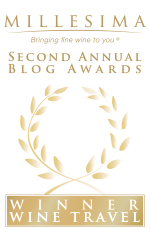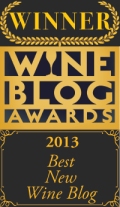After spending the winter months at home in PJ’s, undergoing pre-China Pimsleur coursework, muttering out loud to my Doberman “wo bu ming bai” (“I have no idea what the heck you are saying to me”); followed by spring months honing my Putonghua with the dry-cleaner (who I later found out is Korean!), I have gone and returned from a 3 week jaunt across the mainland of China and Hong Kong; and since forgotten most of my Mandarin. What I did grasp came in handy and generally broke the ice with locals—apparently it was hilarious that I, the blond-haired, blue-eyed wife of a partially Chinese husband, traveling with my partially Chinese father-in-law, was the only one who could bust out phrases in the native tongue.
As far as my goal of grasping the state of wine culture in the Motherland, that was a little more difficult. The first half of the trip was dedicated to adventure travel: we traipsed through remote-ish places with limited exposure to modern wine culture (we still found weird, fermented “wines” such as made from snakes).
The second half was dedicated to the major cities of Beijing, Shanghai and Hong Kong, but we had my 80+ year old in-laws, in-tow, and they weren’t particularly interested in patronizing wine bars or the kind of restaurant that might have a wine list (we ate a lot of down and dirty—and delicious—food geared towards locals). Yet, despite what I can hardly consider obstacles, I was still able to bring home a few observations about the state of the wine market for the mid-level consumer from both a retail and Café/Restaurant/Hotel standpoint. If you read my piece on Where I am going: China, you will remember I offered some market analysis and speculation, largely based on my reading of 3rdparty resources. Now that I have had two feet on their turf, I thought I would follow-up with a few impressions:
- Wines are CRAZY expensive on the mainland. China’s import tariff is staggeringly high at 50%; despite the abolishment of such tariffs in Hong Kong, Central is still sticking it to the ZhongGuoRen consumer and businesses. This is a short-sighted strategy given the huge, potential market and money to be made, particularly if the duty’s purpose is protectionism—a failing proposition as evidenced in history.
- Bottles that cost $10/20/30 in the United States sold closer to $30/60/90 in groceries or department stores. Yellowtail priced at $7 bucks in the United States, cost over $22 in a Shanghai shop.
- Wine by the glass at bars and restaurants is limited or non-existent. Most wine is sold by the bottle at such incredible mark-ups, even The Donald would blush. This was always the case at bars geared towards the Chinese. Bars and restos with broader international appeal, such as found in the Sanlitun district of Beijing or at wine bars operated by non-chinese (such as H.O.W. aka House of Wine in Shanghai, owned by a Frenchman), tended to have more interesting bottle selections with by the glass programs that were, relatively speaking, affordable.
- Horrible storage conditions. Apparently importers don’t include leaflets on ideal storage temps when they drop off their shipments. We saw countless bottles of wine—some high-priced Bordeaux(!)—standing upright, baking in sunny windows, and covered with dust.
- There were entire wine shops dedicated to high-end Bordeaux and Barolo. Nothing else. All luxury, no middle ground, all over-priced.
- Wine shops with a broader selection, still tended to carry 60-70% French wine. They are obsessed with it. Second place goes to Italy, but only Barolo and wines from Tuscany. I keep reading the American wine companies have made the biggest dent in the market, but from the ground, it all looked French and Italian to me.
- The “high-end” or better Chinese wines, mentioned in my previous article, were very difficult to find. Grace Vineyards, for instance, never graced a shelf I surveyed. Granted, I didn’t have time for major recon of every city’s best shops, so take that with a few salty granules.
- Mid-range and low-end wines from the most prolific Chinese producers such as Great Wall and Changyu, were available in a few spots, but again, not as common as I expected. We managed to find a shop in Lijiang that sold some mid-range stuff ($25), so we bought a bottle of Changyu red for tasting. See my post on that bottle.
All in all, China has massive market potential and those getting an early foot in the door should make some bucks—whether through importing or working with local wineries, such as international partnerships with Chinese vineyards. For those of us more interested in unique, small-produced wines from less trendy regions, Hong Kong has a population more open to learning and experimenting without any of the tariffs.
















Pingback: What I Drank – Changyu Dry Red Wine, Vintage Unknown | CHASING THE VINE
Thank you for the post. It’s interesting how eyes on the ground reveal such different information than is typically found online… I feel better about wine’s immediate future after reading your observations.
Great posts on China – I’m heading to Shanghai for a short break next week. Any suggestions for must do’s on from a wine perspective? Thanks!
Hi! Shanghai has a few wine joints, maybe more since I was there.
Overall, the prices are quite steep for what you get due to the taxation of imports, so lower expectations a bit!
Dr. Vino (there is also a Dr. Beer) is a fun spot. Roosevelt Cellar and Wine Vault has an expensive list but a few by the glass options if you just want to
ogle their massive collection and sit in front of the window offering gorgeous views of Pudong over the river. In the evening, in the same building as Roosevelt, you can head to the roof and drink wine and watch the city twinkle. M on the Bund has a very cool bar, also offering wine. The decor is fun, great views and last year they had a special running: $3.50 (U.S.) for a foie gras lollipop and glass of Champagne before 8 pm during summer nights. We went every evening we were in town! Check out if they are doing it again this year. Hope this helps a little. There is another little place that I can’t remember off the top of my head. If I do, will reply again.
That is a fantastic list – many thanks!